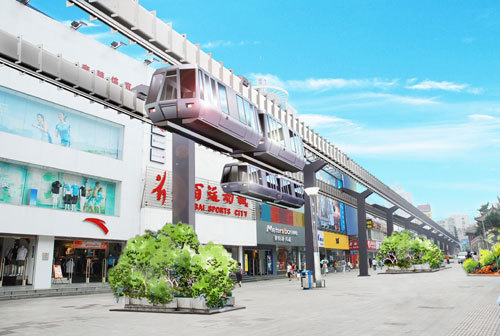New solutions raised for traffic gridlock
|
|
|
An artistic rendition of the H-Bahn, or hanging railway. |
As traffic jams in China's big cities have become increasingly common, so have the ways proposed to ease the gridlock.
And the solutions being bandied about range in type from the commonplace to the whimsical.
On Monday, a vehicle developed in Germany and called the H-Bahn, or hanging railway, was introduced to China.
The hanging monorail system, which is composed of four passenger cabins suspended from an overhead track that is supported by iron pillars, is said to be designed to go about 50 km an hour and to transport 75 passengers in each of its cabins, according to Lin Youling, president of the China Business Unit of Air Train International, which introduced the technology to China.
So far, no city on the mainland has the system, although it has been running for years in some European countries.
Also on Monday, construction began on a "maglev line" - which use magnets to levitate a train above a track - between the Mentougou district and the downtown of Beijing.
Last year, Song Youzhou, an inventor from Shenzhen, promoted his idea of a "straddle bus" in Beijing, in the hope that his invention could be used to help ease the capital's chronic traffic gridlock.
The bus puts passengers on an upper deck while its lower portion straddles the road, leaving enough space for vehicles less than 2 meters in height to drive under it. Media have reported that Beijing's Mentougou district has expressed interest in the idea.
The question now is which of these methods of public transport have a place in cities' battles against traffic jams, said Duan Liren, a professor specializing in transportation at Chang'an University.
"Cities now have a high density of buildings, and subways cannot be the only solution for urban transit," he said, adding that the proposed methods would complement subways and light rails.
Wang Mengshu, a member of the Chinese Academy of Engineering, believed that the advantages in the newly proposed transport methods come from their costing less and taking less time to build.
"Many medium and small cities are not in a position where they can build subways, given their populations, GDPs and other factors," he said.
"And even if they are allowed to build them, the cost of operating the subways will be huge."
The alternative solutions, he said, can often be built for less.
But despite the advantages, those proposing the new transport methods find it difficult to tap into lucrative markets.
Song, who devised the straddle-bus and whose invention was cited by Time Magazine as one of the 50 best inventions of 2010, told China Daily on Monday that his company has received orders for the straddle bus from Brazil and Spain, but local governments are still reluctant to put the technology to use.
"Local governments are cautious about using transport methods that are still in the experimental phase," he said.
He added the car prototype will debut this July and, in a trial run, travel a route in the Mentougou district.
 0
0 








Go to Forum >>0 Comments